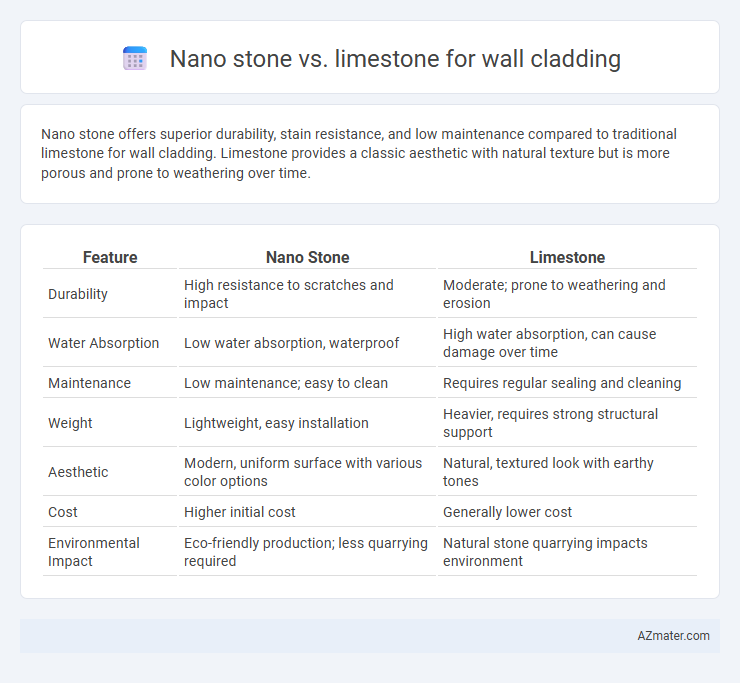Nano stone offers superior durability, stain resistance, and low maintenance compared to traditional limestone for wall cladding. Limestone provides a classic aesthetic with natural texture but is more porous and prone to weathering over time.
Table of Comparison
| Feature | Nano Stone | Limestone |
|---|---|---|
| Durability | High resistance to scratches and impact | Moderate; prone to weathering and erosion |
| Water Absorption | Low water absorption, waterproof | High water absorption, can cause damage over time |
| Maintenance | Low maintenance; easy to clean | Requires regular sealing and cleaning |
| Weight | Lightweight, easy installation | Heavier, requires strong structural support |
| Aesthetic | Modern, uniform surface with various color options | Natural, textured look with earthy tones |
| Cost | Higher initial cost | Generally lower cost |
| Environmental Impact | Eco-friendly production; less quarrying required | Natural stone quarrying impacts environment |
Introduction to Wall Cladding Materials
Wall cladding materials enhance both the aesthetic appeal and durability of building exteriors and interiors. Nano stone offers advanced properties like high strength, lightweight, and resistance to weathering, making it suitable for modern architectural designs. Limestone provides a timeless, natural texture with excellent thermal insulation but requires maintenance to prevent erosion and staining over time.
What is Nano Stone?
Nano stone is an advanced engineered material designed for wall cladding, created by compacting natural minerals at a molecular level to enhance durability and aesthetic appeal. It features superior resistance to weathering, scratches, and stains compared to traditional limestone, making it ideal for both interior and exterior applications. Unlike limestone, nano stone offers a consistent surface texture and color, ensuring a modern, sleek finish tailored for contemporary architectural designs.
Understanding Limestone in Wall Cladding
Limestone is a sedimentary rock composed mainly of calcium carbonate, valued for its durability and natural aesthetic in wall cladding applications. Its porous texture offers excellent insulation properties and allows for versatile design options, ranging from polished finishes to rough-hewn rustic looks. Compared to nano stone, limestone provides a classic, timeless appeal but may require more maintenance to prevent weathering and discoloration over time.
Aesthetic Comparison: Nano Stone vs Limestone
Nano stone offers a sleek, modern aesthetic with a uniform texture and vibrant color consistency that enhances contemporary wall cladding designs. Limestone provides a natural, timeless appeal with rich, earthy tones and unique fossil patterns that add character and warmth to any space. The aesthetic choice between nano stone and limestone depends on whether a polished, minimalistic look or a rustic, organic appearance is desired for the wall cladding project.
Durability and Strength Analysis
Nano stone exhibits superior durability compared to limestone due to its enhanced resistance to weathering, abrasion, and chemical erosion, making it ideal for long-term wall cladding applications. The compressive strength of nano stone typically surpasses limestone, providing better structural support and reduced susceptibility to cracking or chipping. Limestone's porosity may lead to higher water absorption and potential degradation, whereas nano stone's nano-engineered surface reduces moisture penetration and maintains integrity under harsh environmental conditions.
Maintenance Requirements
Nano stone offers superior resistance to stains and moisture, significantly reducing the frequency and intensity of maintenance compared to traditional limestone. Limestone, being porous, demands regular sealing and more frequent cleaning to prevent discoloration and damage from environmental factors. Choosing nano stone for wall cladding minimizes long-term upkeep costs and effort, providing a durable and low-maintenance surface ideal for both interior and exterior applications.
Cost Considerations
Nano stone offers a cost-effective solution for wall cladding due to its lower installation and maintenance expenses compared to traditional limestone. Limestone's higher material costs and susceptibility to weathering often result in increased long-term expenses for repairs and upkeep. Choosing nano stone can significantly reduce overall budget concerns while maintaining aesthetic appeal and durability.
Environmental Impact
Nano stone wall cladding offers a significantly lower environmental impact compared to limestone due to its production process, which requires less energy and generates fewer carbon emissions. Limestone extraction involves quarrying, resulting in habitat disruption, sedimentation, and a high carbon footprint from heavy machinery use. Choosing nano stone supports sustainable building practices by reducing natural resource depletion and minimizing waste through advanced manufacturing techniques.
Installation Process Overview
Nano stone offers a lightweight and thin profile that simplifies the installation process for wall cladding, allowing for quicker application and less structural stress compared to traditional limestone panels. Limestone requires careful handling due to its heavier weight and porosity, often necessitating specialized adhesives and sealants to ensure durability and moisture resistance. Both materials benefit from precise cutting tools and professional labor, but nano stone typically reduces installation time and labor costs because of its engineered consistency and ease of customization.
Choosing the Right Material for Your Project
Nano stone offers superior durability and resistance to weathering compared to traditional limestone, making it ideal for exterior wall cladding in harsh environments. Limestone provides a natural, timeless aesthetic with excellent thermal insulation properties but requires more maintenance due to its porosity. Selecting the right material depends on project requirements such as durability, maintenance capacity, budget, and desired visual appeal.

Infographic: Nano stone vs Limestone for Wall Cladding
 azmater.com
azmater.com